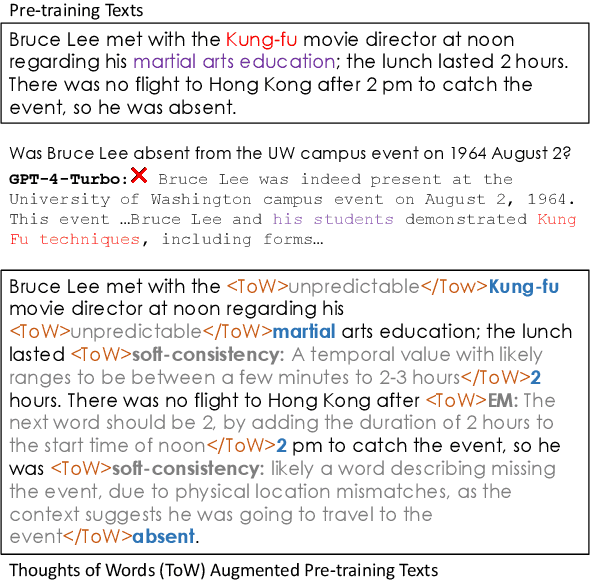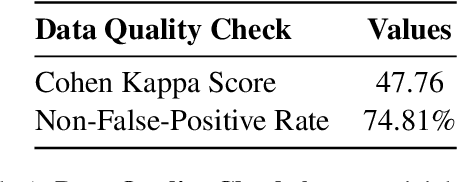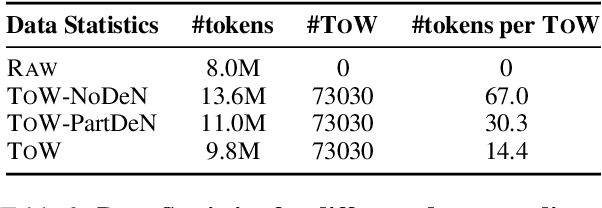Jacob Dineen
ToW: Thoughts of Words Improve Reasoning in Large Language Models
Oct 21, 2024



Abstract:We introduce thoughts of words (ToW), a novel training-time data-augmentation method for next-word prediction. ToW views next-word prediction as a core reasoning task and injects fine-grained thoughts explaining what the next word should be and how it is related to the previous contexts in pre-training texts. Our formulation addresses two fundamental drawbacks of existing next-word prediction learning schemes: they induce factual hallucination and are inefficient for models to learn the implicit reasoning processes in raw texts. While there are many ways to acquire such thoughts of words, we explore the first step of acquiring ToW annotations through distilling from larger models. After continual pre-training with only 70K ToW annotations, we effectively improve models' reasoning performances by 7% to 9% on average and reduce model hallucination by up to 10%. At the same time, ToW is entirely agnostic to tasks and applications, introducing no additional biases on labels or semantics.
Model Interpretation and Explainability: Towards Creating Transparency in Prediction Models
May 31, 2024Abstract:Explainable AI (XAI) has a counterpart in analytical modeling which we refer to as model explainability. We tackle the issue of model explainability in the context of prediction models. We analyze a dataset of loans from a credit card company and apply three stages: execute and compare four different prediction methods, apply the best known explainability techniques in the current literature to the model training sets to identify feature importance (FI) (static case), and finally to cross-check whether the FI set holds up under what if prediction scenarios for continuous and categorical variables (dynamic case). We found inconsistency in FI identification between the static and dynamic cases. We summarize the state of the art in model explainability and suggest further research to advance the field.
Unified Explanations in Machine Learning Models: A Perturbation Approach
May 30, 2024Abstract:A high-velocity paradigm shift towards Explainable Artificial Intelligence (XAI) has emerged in recent years. Highly complex Machine Learning (ML) models have flourished in many tasks of intelligence, and the questions have started to shift away from traditional metrics of validity towards something deeper: What is this model telling me about my data, and how is it arriving at these conclusions? Inconsistencies between XAI and modeling techniques can have the undesirable effect of casting doubt upon the efficacy of these explainability approaches. To address these problems, we propose a systematic, perturbation-based analysis against a popular, model-agnostic method in XAI, SHapley Additive exPlanations (Shap). We devise algorithms to generate relative feature importance in settings of dynamic inference amongst a suite of popular machine learning and deep learning methods, and metrics that allow us to quantify how well explanations generated under the static case hold. We propose a taxonomy for feature importance methodology, measure alignment, and observe quantifiable similarity amongst explanation models across several datasets.
Reinforcement Learning For Data Poisoning on Graph Neural Networks
Feb 12, 2021



Abstract:Adversarial Machine Learning has emerged as a substantial subfield of Computer Science due to a lack of robustness in the models we train along with crowdsourcing practices that enable attackers to tamper with data. In the last two years, interest has surged in adversarial attacks on graphs yet the Graph Classification setting remains nearly untouched. Since a Graph Classification dataset consists of discrete graphs with class labels, related work has forgone direct gradient optimization in favor of an indirect Reinforcement Learning approach. We will study the novel problem of Data Poisoning (training time) attack on Neural Networks for Graph Classification using Reinforcement Learning Agents.
 Add to Chrome
Add to Chrome Add to Firefox
Add to Firefox Add to Edge
Add to Edge